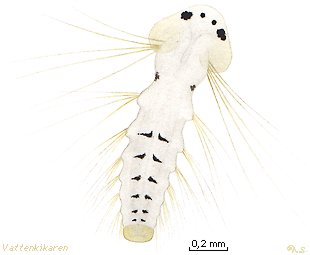 |
 |

 Distribution in scandinavian waters |
Maximum length: It is difficult finding
information about the largest metatrochophore larva, but you can
compare a larva with a hair. Appearance: Metatrochophore larvae have a body that is divided into a series of identical segments. On every segment, two-branched outgrowths are present with a long brush in each. The head is distinct. Depth: From the surface to unknown depth. Environment: Pelagic. Misc: When the eggs from many different specie hatch in the sea, a larva emerges. During this primary stage, the larva do not resemble adults and furthermore do not have the same life style. Most polychaetes hatch as trochophora larvae, that later transform into larvae that resemble the above pictured. It is when it becames segmented that it is called a metatrochophore larva. Metatrochophore larvae are most common during the summer half of the year, but can even be found during the winter. The period of time that the larvae are pelagic varies greatly between the different specie. Classification: Polychaetes are members of the segmented worm group. The larva pictured above is of the Polydora family. |